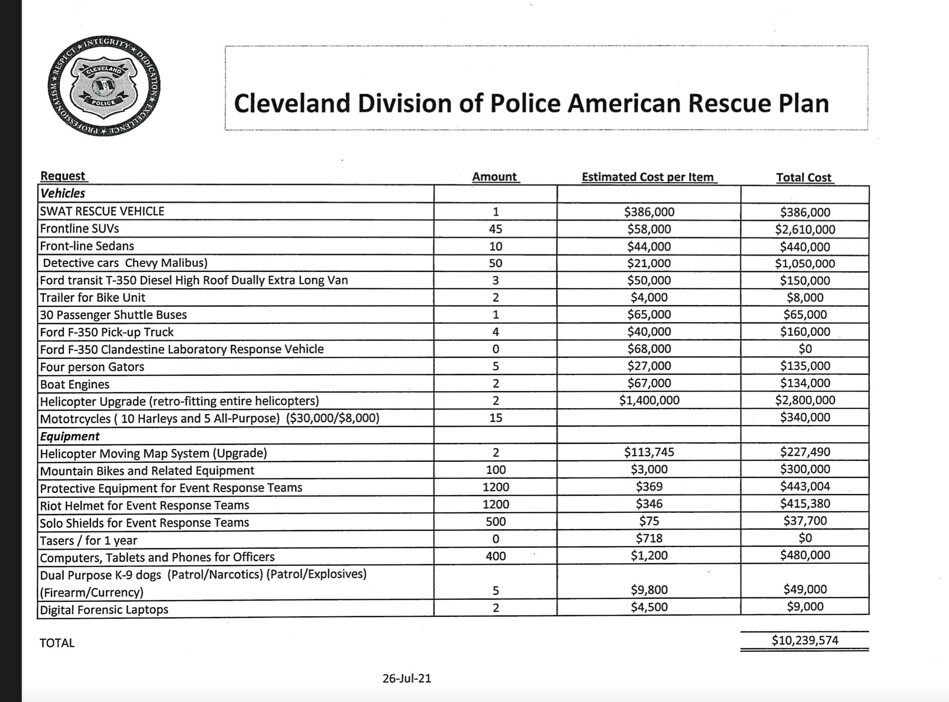CLEVELAND — From the ongoing pandemic to the increases in gun violence, Cleveland’s public safety forces have been under tremendous strain over the past two years. To help offset the increased workload and wear-and-tear on public safety vehicles, Mayor Frank Jackson has proposed allocating $26 million in American Rescue Plan Act (ARPA) funding to make needed investments in public safety, including dozens of new patrol vehicles, ambulances, and other equipment.
The City Council’s Safety Committee reviewed and discussed the proposed allocations at a hearing on Wednesday that spanned nearly four hours. Council members were provided a line-item summary of the mayor’s recommendations. Of the $26 million, the recommendations include $10.2 million in expenditures for the Division of Police; $3.6 million for the Division of Fire; $7.8 million for the Division of EMS as well as nearly $4.5 million for the Division of Public Safety’s IT department to be used to upgrade the city’s video surveillance and real-time crime monitoring program.
Included in the recommendations for the Division of Police are 45 new patrol SUVs, 10 sedans, and 50 vehicles for detectives. A $386,000 line item for a new SWAT rescue vehicle. Chief Calvin Williams told council members that the current rescue vehicle for the SWAT unit is nearing the end of its lifespan.

Early in the pandemic, the Division of Police was forced to modify its car plan in order to accommodate social distancing between officers.
“The strain that COVID has put on our emergency response vehicle, we had to move officers onto individual car plans for a while because we didn’t know and weren’t familiar with COVID,” said Public Safety Director Karrie Howard. “Our vehicles had extreme wear and tear. [Public safety forces carrying out the demands [of the city] requires a constant evaluation of our equipment, vehicles, and technology. The evaluation that has been ordered by the administration is consistent with the advice and voice of the public being that public safety is a priority.”
Last month, Jackson announced his recommendations for the $511 million that the city will receive by 2022 through the American Rescue Plan. In that announcement, officials said public safety was one of the top responses when the city sought input from residents on how to best use the stimulus money.
The $26 million in recommended spending for public safety also includes the purchase of 15 new ambulances for the Division of EMS, which would be enough to replace roughly half of the division’s aging fleet of response vehicles.
Ward 6 Councilman Blaine Griffin was somewhat critical of several of the recommendations for the Division of Police, namely nearly $900,000 allocated for new protective equipment, riot helmets, and shields for the division’s event response teams.
“I see a lot of equipment, basically, being built up for civil unrest,” Griffin said. “I know that we have to focus a lot on equipment and — maybe I’m missing something — but I thought we were looking more at cameras, gun sensor technology, and those kinds of tools.”
Howard said the equipment isn’t solely for civil unrest.
“It’s just an uplift of the equipment that the Division of Police needs for the myriad of situations — foreseeable and unforeseeable — that would arise,” Howard said.
After the May 30, 2020 protests-turned-riots following the death of George Floyd, the federal monitor overseeing the city’s consent decree with the Department of Justice noted in its report that much of the division’s riot gear, which was obtained prior to the 2016 Republican National Convention, did not have the proper amount needed so that an officer’s body camera could be affixed to it. Because of this, the monitor’s report noted that only two-thirds of the uses of force reported by officers had accompanying video evidence. The monitor recommended that the division address this issue.
With a recommended $4.4 million investment, Howard said the city would be able to add an additional 429 cameras across 127 locations in the city to be used as part of the real-time crime surveillance system.
City Council has until Nov. 1 to make its own recommendations on stimulus spending.



